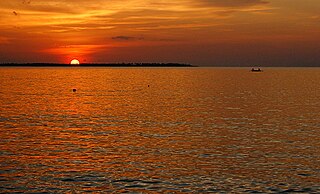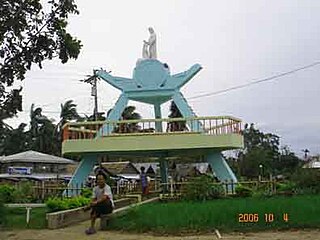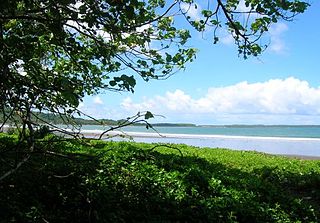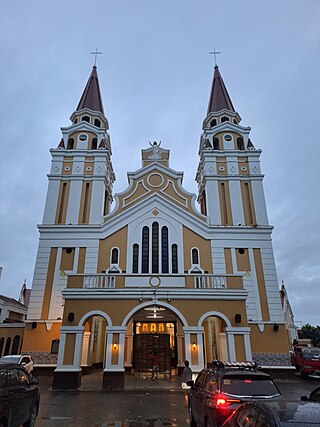
Abuyog, officially the Municipality of Abuyog, is a municipality in the province of Leyte, Philippines. According to the 2020 census, it has a population of 61,216 people.

Alangalang, officially the Municipality of Alangalang, is a 2nd class municipality in the province of Leyte, Philippines. According to the 2020 census, it has a population of 57,185 people.

San Julian, officially the Municipality of San Julian, is a 5th class municipality in the province of Eastern Samar, Philippines. According to the 2020 census, it has a population of 14,800 people.

Dulag, officially the Municipality of Dulag, is a 3rd class municipality in the province of Leyte, Philippines. According to the 2020 census, it has a population of 48,992 people.

Bulusan, officially the Municipality of Bulusan, is a 4th class municipality in the province of Sorsogon, Philippines. According to the 2020 census, it has a population of 23,932 people.

Calbiga, officially the Municipality of Calbiga, is a 4th class municipality in the province of Samar, Philippines. According to the 2020 census, it has a population of 23,310 people. The town is famous for the Langun-Gobingob Caves which is the largest cave system in the Philippines, reputed to be the second largest in Asia and the world's third largest karst formation.

Gandara, officially the Municipality of Gandara(Waray: Bungto han Gandara), is a 2nd class municipality in the province of Samar, Philippines. According to the 2020 census, it has a population of 35,242 people.

Pagsanghan, officially the Municipality of Pagsanghan, is a 5th class municipality in the province of Samar, Philippines. According to the 2020 census, it has a population of 7,959 people.

Tarangnan, officially the Municipality of Tarangnan, is a 4th class municipality in the province of Samar, Philippines. According to the 2020 census, it has a population of 25,713 people.

Laoang, officially the Municipality of Laoang, is a 2nd class municipality in the province of Northern Samar, Philippines. According to the 2020 census, it has a population of 61,607 people.

Las Navas, officially the Municipality of Las Navas, is a 4th class municipality in the province of Northern Samar, Philippines. According to the 2020 census, it has a population of 36,621 people.

Pambujan, officially the Municipality of Pambujan, is a 4th class municipality in the province of Northern Samar, Philippines. According to the 2020 census, it has a population of 35,532 people.

Borongan, officially the City of Borongan, is a 1st class component city and capital of the province of Eastern Samar, Philippines. According to the 2020 census, it has a population of 71,961 people.

Guiuan, officially the Municipality of Guiuan, is a 2nd class municipality in the province of Eastern Samar, Philippines. It constitutes the southeastern extremity of Samar Island and some adjacent islands, surrounded by Leyte Gulf and the Philippine Sea, two major bodies of water that makes the town the surfing capital of the Visayas. According to the 2020 census, it has a population of 53,361 people, making it the most populous municipality in Eastern Samar and the second most populous administrative division in the entire province after the capital city Borongan.

Sogod, officially the Municipality of Sogod, is a 2nd class municipality in the province of Southern Leyte, Philippines. According to the 2020 census, it has a population of 47,552 people.

Unisan, officially the Municipality of Unisan, is a 4th class municipality in the province of Quezon, Philippines. According to the 2020 census, it has a population of 25,448 people.

Palompon, officially the Municipality of Palompon, is a 2nd class municipality in the province of Leyte, Philippines. According to the 2020 census, it has a population of 58,313 people.

Catbalogan, officially the City of Catbalogan, is a 5th class component city and capital city of the province of Samar, Philippines. According to the 2020 census, it has a population of 106,440 people.

The San Pedro Apostol Parish Church, commonly known as Loboc Church and alternatively as the Diocesan Shrine of Our Lady of Guadalupe in Extremadura, is a Roman Catholic church in the municipality of Loboc, Bohol, Philippines, within the jurisdiction of the Roman Catholic Diocese of Tagbilaran.

The Metropolitan Cathedral of Our Lord's Transfiguration, also known as Palo Metropolitan Cathedral or simply Palo Cathedral, is a Roman Catholic church located at Palo, Leyte, in the Philippines belonging to the Vicariate of Palo under the Metropolitan Archdiocese of Palo.




















